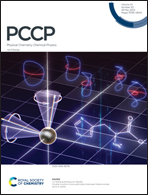Energy harvesting from mechanical vibrations: self-rectification effect†
Abstract
The use of environmental vibrations as an energy source for stimulating small-scale energy harvesting (EH) devices has received significant attention in recent years. The conversion of alternating currents (AC) to direct currents (DC) is essential to powering electronic devices effectively. This study proposes a method where hexagonal boron nitride nanoribbons and nanotubes harvest energy and rectify the output voltage simultaneously with no need for an external rectifying circuit. This is a step to eliminate the necessity of batteries for EH devices, which require a constant power supply to generate electrical energy while maintaining their nanoscale dimensions. A molecular dynamics approach was used to simulate the response of boron nitride structures to mechanical vibrations. The polarization and voltage generated under tensile and compressing strain fields were calculated, and it was demonstrated that the buckling of the nano-mechanical structures could be engineered to rectify the generated voltage. This paves the way for the design of more efficient and scalable energy harvesting devices.



 Please wait while we load your content...
Please wait while we load your content...